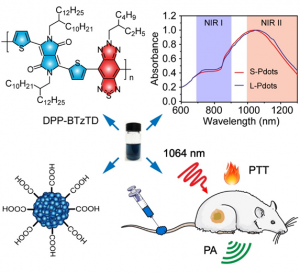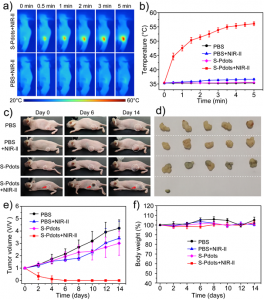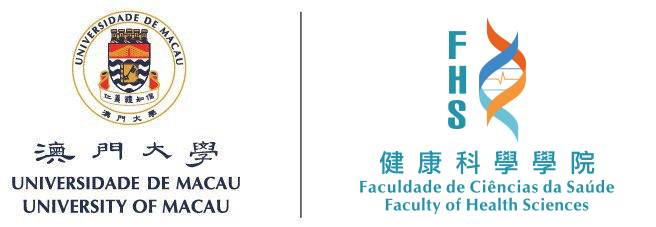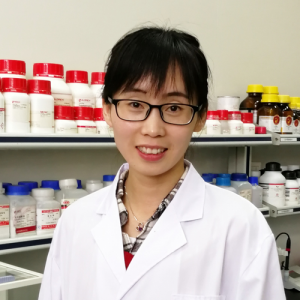A research team in the University of Macau (UM) Faculty of Health Sciences (FHS), led by Associate Professor Zhen YUAN, has made significant progress in optical molecular imaging and precision medicine for cancer treatment. The team has developed an efficient strategy to prepare ultra-small organic polymer probes for second near-infrared (NIR-II) photoacoustic imaging-guided cancer diagnostic tests and phototherapy. The study paves the way for clinical applications of organic semiconductor nanoprobes, and has been published in the authoritative international journal Advanced Functional Materials (Impact Factor: 15.621).
Theranostic nanoagents, which incorporate diagnostic and therapeutic capability, have emerged as a promising nanoplatform for cancer detection and treatment. As multifunctional and all-in-one or one-for-all probes, theranostic nanoagents can provide more comprehensive and accurate information for cancer detection and treatment, representing a new trend in nanomedicine for cost-effective precision medicine. Meanwhile, multiscale photoacoustic imaging (PAI) and photothermal therapy (PTT) in NIR-II window (1000–1700 nm) hold great promise for clinical precision medicine for their greater penetration depth and minimal tissue exposure. However, the development of such integrated diagnostic and therapeutic techniques is largely hampered by the lack of metabolisable NIR-II phototheranostic agents.
Prof Yuan’s team constructed a biodegradable NIR-II highly absorbing conjugated polymer dots (Pdots) with rapid clearance for PAI-guided PTT. The unique design of low-bandgap D-A p-conjugated polymer (DPP-BTzTD), together with a modified preparation method, allow the researchers to fabricate Pdots in ultrasmall particle size. Extensive experimental tests have demonstrated that the constructed Pdots exhibit excellent photostability, strong NIR-II absorption, good biocompatibility, bright PA signals, and high photothermal conversion efficiency (53%). In addition, upon tail-vein intravenous injection, Pdots can also ablate tumours efficiently and excrete rapidly through the renal filtration system. In particular, both in vitro and in vivo assays have indicated that the Pdots possess a remarkable PTT performance under the irradiation of a 1,064 nm at 0.5 W cm-2, which is much lower than its maximum permissible exposure limit of 1 W cm−2. This pilot study thus paves a novel avenue for the development of organic semiconducting nanoagent for future cancer translation studies. The study was led by Prof Yuan and his PhD student Xiaojun MEN. It was supported by UM and the Macao Science and Technology Development Fund.
Prof Zhen YUAN’s academic investigation focuses on cutting-edge research and development in laser, ultrasound and EEG/fMRI-related biomedical technologies as well as their clinical/pre-clinical applications in neuroimaging and neurosciences, and optical molecular imaging and biomedical optics.
Prof Yuan’s team is dedicated to studying the principles of original imaging in biomedical optics and prototype optics, and has realised the transformation from theranostic imaging to quantitative functional imaging for the first time in world history. Prof Yuan is also one of the pioneers in the early development of continuous wave near-infrared functional imaging. The technology has been approved by the United States Food and Drug Administration in clinical diagnostic tests for brain diseases. Prof Yuan has received international recognition through publishing nearly 200 research articles in high-ranked SCI journals. He is an editorial board member of Quantitative Imaging in Medicine and Surgery, associate editor of BMC Medical Imaging, and associate editor of Frontiers in Human Neuroscience. He is also a senior member of the Optical Society and International Society for Optics and Photonics, a board member of a specialised committee in biomedical sciences under the Chinese Optical Society, and the vice president of the Macao Society of Nuclear Medicine and Molecular Imaging.

Ultrasmall Polymer Probes used in NIR-II cancer phototherapy

Ultrasmall Polymer Probes used in NIR-II cancer photothermal therapy



